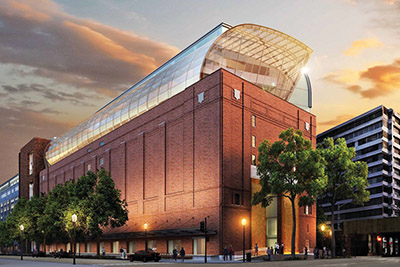
Should Orthodox families and yeshiva day schools visit this museum, which opened just before Thanksgiving in Washington, D.C.? It was founded, and to a large extent paid for, by the Evangelical Christian family who are the owners of the 600-store Hobby Lobby chain, who successfully challenged Obamacare’s mandate to pay for morning-after pills in the Supreme Court. Is this museum a subterfuge for Christian indoctrination? I went to find out.
I was simultaneously blown away, and underwhelmed, by the Museum of the Bible.
If a Martian’s first exposure to the Bible was this museum, he’d guess that approximately 50 percent of this nation is Jewish. The Old Testament is called Hebrew Bible and Tanakh, and there are verses in the original Hebrew throughout. It’s truly remarkable that there is a sofer on staff who sits in the middle of the museum writing a sefer Torah (blown up on a large-screen TV so you can see him working) and 100 sifrei Torah from all over the world are displayed.
You hear Hebrew as well; one exhibit has Tehillim read and sung in the background, and another has a dining room table at which you alternately hear a Seder and a Friday night dinner. The Israeli government sent two exhibits of archeological finds combined with movies (there’s a mezuzah on the door of the exhibit) showing how archeological finds are discovered and identified in Israel. There’s presently a fascinating collection of rare European sefarim, letters and Judaica on display entitled “Amsterdam, A City of Jewish Books.”
It’s hard to imagine a believing Christian coming out of this museum with even a tinge of anti-Semitism. Judaism, Jewish scholarship, Jewish practice, Jewish history are all revered in these walls. When it speaks about communism, an exhibit says that Jews and Christians smuggled Bibles into Soviet Russia. In a moving display about book burning, Holocaust is mixed with burnings of books by Christian churches. The message is that we have common cause and common enemies. If that is all that is accomplished by this museum, dayeinu.
Everything I saw was factually correct. At no point did I feel “oh, that’s the way they understand this, but we understand it differently.” They clearly had rabbis who explained to them our point of view. In general, when a verse is translated into English, the source of the translation is noted (eg. Jewish Publication Society). A sign by the sifrei Torah even said that “the Masoretic Text of the Jewish Tanakh has remained unchanged for thousands of years.”
Proving that the Bible really happened is one of the clear missions of the museum. “History of the Bible” (Floor 4) has large facsimiles of many ancient documents (such as the Tel Dan and Mesha Steeles and the Dead Sea Scrolls) that mention biblical figures or stories. As parents and teachers educating children in a religiously skeptical science-based world, I felt that this section was particularly important for us. I was much more at home here than at the Bible Lands Museum in Jerusalem.
Bible in America is fascinating (Floor 2), with sections about the founding fathers, slavery and equal rights, and quotes by major figures in American history about the centrality of the Bible to who we are as a nation.
For those who aren’t interested in historical artifacts, there are sections of the museum they’ll want to skip over. The museum is an outgrowth of the Green family’s collection of Bible-related artifacts. Not everyone is interested in the Tanach presented by Israel’s first Ambassador to the U.S. to President Harry Truman, Tanachs published in Kaifeng, China, etc.
Skipping the New Testament-related exhibits is not difficult at all. They are clearly marked. It seemed to me that they made an effort to make non-Christians comfortable. Despite the time of year, there were no Christmas decorations,
So why was I disappointed? Although attempts were made to make the Bible come alive, I would have thought that for $500 million, I would feel that I was at Krias Yam Suf, Har Sinai and other biblical events. Though there was creativity in many depictions, Cecil B. DeMille has nothing to worry about! (They even included clips of his Ten Commandments in a film about the Bible portrayed in movies). I didn’t come out with a new perspective on anything in Tanach, though I learned that there are a crazy amount of phrases in English whose roots are in our Bible.
The museum’s Milk and Honey Café and Manna Restaurant aren’t kosher, though they say there are two kosher dishes (which I didn’t check out) available upon request. The crowd was decidedly non-Jewish, so I understand.
Should Orthodox families and yeshivot visit? I think it’s certainly worth including this in the itinerary of eighth grade graduation trips and family trips to our nation’s capital, though you don’t have to make a special trip to D.C. for it. One only walks out a prouder Jew, feeling that we are the insiders who haven’t just seen the movie, but we’ve read the book in the original.
By Rabbi Perry Tirschwell
Rabbi Perry Tirschwell is the executive director of the Torah Educators Network, whose mission is to provide services to mechanchim nationwide.










